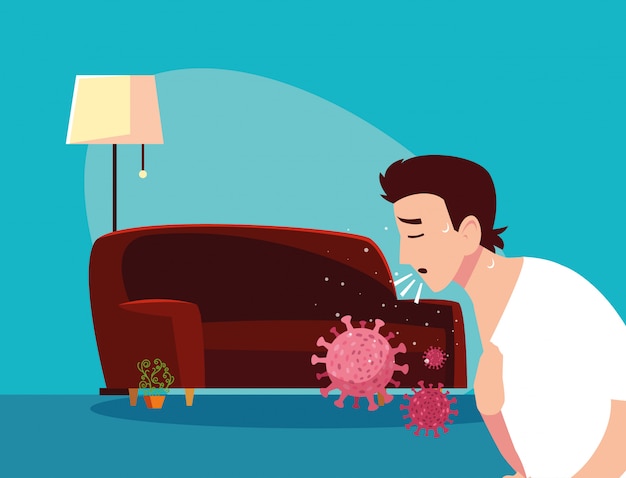
Have you ever wondered why sneezing, itchy nose, or watery eyes persist in you and your family despite regular cleaning? Could your furniture be the hidden culprit affecting your health? Upholstered furniture often harbours allergens and irritants that can compromise indoor air quality and exacerbate allergies. Understanding these hidden risks is key to creating a healthier home environment.
In this blog, you’ll learn how dust and allergens accumulate in upholstery, their effects on your health and some practical steps to minimise exposure. By the end of this article, you will have already learned how to maintain a dust and allergen-free living space for you and your family.
Understanding Dust and Allergens in Upholstery
Upholstered furniture is common in many homes, providing comfort and aesthetic appeal. However, it can also be a significant reservoir for dust, dust mites and various allergens that can affect indoor air quality and health.

What is Dust?
Dust are tiny particles that accumulate over time in indoor and outdoor spaces. It primarily consists of:
- Fibres. These come from clothing, upholstery and carpets.
- Pollen. Outdoor allergens can enter homes through open windows and doors.
- Pet dander. Tiny flakes of skin shed by pets can become embedded in upholstery.
- Microorganisms. Bacteria, mould spores and dust mites are also found in dust.
Dust can be introduced into indoor environments through various means, including:
- Foot traffic. Particles can be tracked in from outside on shoes.
- Air circulation. Dust can be blown in through windows or carried by air currents within the home.
- Human and pet activity. Movement can stir up settled dust, releasing it back into the air.
Dust Mites and Common Allergens
Dust mites are microscopic organisms that thrive in warm, humid conditions. They feed on dead skin cells and are frequently found in upholstered furniture, bedding and carpets. While they do not pose a direct threat to health, their waste products (faeces and body fragments) are potent allergens that can trigger allergic reactions and asthma symptoms in sensitive individuals.
Common allergens found in upholstery include:
- Pet dander. This includes hair and skin flakes from animals, which can exacerbate allergies.
- Pollen. Seasonal allergens can settle on surfaces and contribute to allergy symptoms.
- Mould spores. Moisture accumulation in upholstered furniture can lead to mould growth, releasing spores into the air.
But why does upholstery attract these particles? Factors such as fabric porosity, frequency of use, humidity levels and poor ventilation allow allergens to settle and embed deeply into the material.
- Fabric porosity. The type of fabric used in upholstery plays a significant role in how much dust and allergens it can trap. Porous fabrics tend to hold more particles compared to those with smoother surfaces. This makes regular cleaning essential to reduce allergen buildup.
- Air circulation. Poor indoor air circulation allows dust to settle on surfaces rather than being dispersed. Spaces with limited ventilation may experience higher concentrations of airborne allergens.
- Human and pet activity. Everyday activities such as sitting, moving cushions, or playing with pets can disturb settled dust, causing it to beome airborne again. This movement increases exposure to allergens.
- Environmental factors. Humidity levels are critical for dust mite survival as they thrive in environments with humidity above 50%. High humidity not only supports dust mite populations but also creates ideal conditions for mould growth within upholstery. Conversely, low humidity levels can help reduce these populations but may lead to dry skin or respiratory issues for occupants.
Types of Upholstery and Their Role in Allergen Accumulation
The fabric of your furniture plays a crucial role in allergen accumulation. Let’s explore the different types of upholstery and why some materials are allergen magnets.
Natural Fibres
Natural fibres, such as cotton and wool, are breathable and soft but tend to absorb moisture. This makes them a haven for allergens, as trapped humidity encourages dust mites and mould growth. While they offer a luxurious feel, natural fibres require consistent maintenance to remain allergen-free.
Synthetic Fibres
Synthetic options like polyester and nylon have tighter weaves and, to some extent, are moisture-resistant, making them less allergen-friendly. However, this doesn’t make them immune to dust buildup, especially in high-traffic areas or homes with pets.
Special Cases: Leather and Treated Upholstery
Leather’s less porous surface repels allergens, making it a good choice for allergy sufferers. However, regular cleaning is still necessary to remove dust and prevent leather degradation. Materials with stain-repellent or hypoallergenic coatings, like treated upholstery, can offer additional protection against allergens, but their effectiveness can vary.
Sources of Dust and Allergen Accumulation
Upholstery acts like a magnet for dust and allergens, accumulating them from various sources:
Airborne Particles
Airborne particles like pollen and pet dander settle on upholstery through ventilation systems or simply drifting through the air. Proper ventilation can help reduce this accumulation.
Foot Traffic and Daily Activities
Human movements contribute significantly to dust transfer onto upholstery. Skin cells, hair, textile fibres from clothing and pet movements all introduce new allergens into the home environment.
Environmental Conditions
Humidity levels play a critical role in allergen accumulation. High humidity fosters mould growth and provides an ideal dust mite breeding ground. Seasonal changes can further influence allergen levels within homes.
Health Impacts of Dust and Allergens in Upholstery
Common Allergies and Symptoms
- Dust mite allergies. Dust mites can trigger allergic reactions, leading to symptoms like:
- Sneezing
- Runny nose
- Itchy, watery eyes
- Coughing
- Skin rashes
- Pet dander allergies. People allergic to pet dander may experience symptoms similar to dust mite allergies.
- Mould allergies. Mould exposure can cause respiratory problems, such as:
- Coughing
- Wheezing
- Shortness of breath
- Sinus infections
Respiratory and Long-Term Health Issues
In addition to immediate allergic reactions, exposure to dust and allergens in upholstery can contribute to long-term respiratory problems, including:
- Asthma. Allergens can trigger asthma attacks, making it difficult to breathe.
- Chronic Obstructive Pulmonary Disease (COPD). Long-term exposure to irritants can worsen COPD symptoms.
- Sinusitis. Allergens can inflame the sinuses, leading to chronic sinusitis.
Psychological and Lifestyle Impacts
The health issues associated with dust and allergen exposure can have a significant impact on your overall well-being. These can include:
- Sleep disturbances. Allergic symptoms, such as congestion and coughing, can disrupt sleep patterns.
- Reduced quality of life. Chronic health problems can limit daily activities and reduce overall quality of life.
- Increased stress. Dealing with persistent allergies and respiratory issues can be stressful and emotionally draining.
How to Minimise Dust and Allergen Accumulation
Below are some tips to ensure your upholstery is always clean and allergen-free.
Regular Cleaning Practices
- Regularly vacuum your furniture with an upholstery attachment to remove dust and allergens.
- Have your upholstery deep cleaned with a professional steam cleaning service at least once a year.
- Rotate and flip cushions regularly to ensure even cleaning and prevent dust buildup.
For a deeper clean, consider hiring professional cleaning service providers like Total Cleanz. Our upholstery cleaning services in Singapore ensure your furniture remains clean and allergen-free.
Preventive Measures
- Opt for washable cushion covers that are easy to clean and replace.
- Use air purifiers with HEPA filters to reduce airborne particles in your home.
- Apply hypoallergenic or anti-allergen sprays on furniture, but ensure they are safe for your fabric type.
- Monitor and regulate indoor humidity levels using a dehumidifier. Keep indoor humidity level below 50% to discourage mould growth.
Tips for Selecting Low-Allergen Upholstery
When selecting low-allergen upholstery, it’s essential to consider materials that minimise the accumulation of allergens like dust mites, pet dander and pollen. When it comes to low-allergen materials, leather is the top choice due to its solid surface, hypoallergenic properties and ease of cleaning.
Vinyl fabric is another excellent option; it is durable, moisture-resistant and easy to maintain while also preventing allergen buildup. For households with pets or children, microfibre offers a practical solution as it is stain-resistant and tightly woven, preventing dust from settling into the fabric.
Beyond choosing the right materials, homeowners can further reduce allergens by avoiding overcrowded spaces and opting for hypoallergenic mattresses and pillows. It’s also advisable to select window coverings that are less likely to trap dust, such as blinds, instead of heavy drapes. By making these informed choices, you can create a more allergy-friendly environment in your homes.
Common Myths About Upholstery and Allergens
- Leather is completely allergen-free
Although leather is less porous than fabric, it can still accumulate surface dust and allergens over time. Regularly wiping it with a damp cloth is essential to keeping it clean.
- Vacuuming alone is enough
While vacuuming removes surface-level dust, deep cleaning methods like steam cleaning are necessary to eliminate embedded allergens.
- All upholstery is the same for allergen accumulation
Different upholstery materials may vary in how much they retain allergens. Selecting the right material for your needs can significantly impact allergen levels in your home.
Conclusion
Understanding how indoor pollutants accumulate in upholstery is essential for maintaining a clean and healthy home. Regular cleaning, preventive measures and choosing low-allergen materials can help create a safer and more comfortable living environment for you and your loved ones. A clean, allergen-free home benefits everyone by enhancing air quality and overall well-being.
With Total Cleanz’s expert cleaning services, maintaining a clean, allergen-free home has never been easier.








